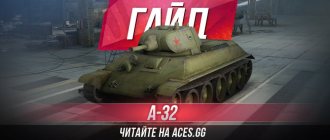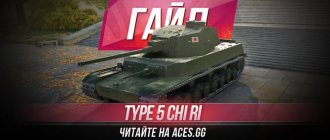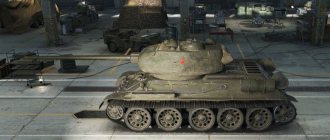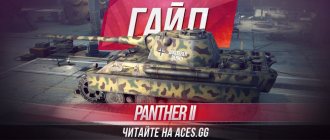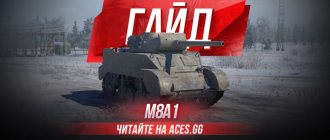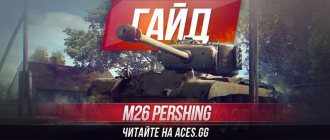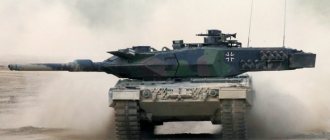The rebalance of medium tanks reached the Leopard 1 branch and gave us the best sniper in World of Tanks. As Germany's top alternative medium tank, this tank embodies the best of previous models and has undergone a number of changes.
Leopard 1 received a noticeable increase in firepower, slightly less noticeable in terms of mobility, but paid for this with a decrease in survivability.
How he feels in random now and how his gameplay has changed, read on.
TTX Leopard 1
Let's take a closer look at the characteristics of the tank compared to other tier 9 tanks to more clearly see the differences.
Firepower
Leopard 1 was equipped with a 105 mm gun with a single damage of 420 units, which is one of the highest values. All three types of shells were replaced.
The sub-caliber remained as the base one, but the armor penetration increased to 278 mm - the highest value among the ST 10. Previously, the special (gold) projectile was cumulative, but now it is also a sub-caliber with an armor penetration of 323 mm.
Ammunition characteristics:
The ammunition consists of 60 shells, all of which have a very high flight speed.
Long-range shooting is facilitated by a fast aiming time of 1.63 seconds. and excellent accuracy of 0.28 - the best performance among classmates. Vertical guidance angles are -9...+20°, but if you turn the gun towards the stern, then due to the elongated hull the gun will not be able to lower to -9°. The turret rotation speed is 41.72°, which is quite enough for sniper tactics, but not enough for close combat.
For increasing the alpha strike, the tank's reload time was increased to 8.92 seconds, which allows it to fire 6.73 shots per minute with a potential damage of 2826 units.
Vitality
For increasing firepower, the safety margin was reduced to 1850 units, which became one of the minimum values. The booking has not changed in any way, if only for the reason that things can’t get any worse. In the frontal projection of the hull, the nominal armor is 70 mm at an acute angle, so the reduction there is 140 mm, which in any case is not enough for level 10. The hull and stern are completely cardboard, 35 mm and 25 mm, respectively.
Its turret is the thinnest among all STs - 52 mm at the forehead, with a protruding roof, but sometimes you can catch a ricochet from the gun mantlet, which occupies most of the front part of the turret. At the slightest turn, even 8 levels will pierce it with 100% probability.
You should avoid encounters with high-explosive opponents and beware of artillery, which can cause full damage.
Other indicators
Leopard 1 has a mass of 40 tons, which, with a specific power of 20.75 hp/t, allows it to accelerate to a record speed of 70 km/h forward and 23 km/h in reverse. The turning speed of the chassis is a pleasantly pleasing 52.15°, so it will not experience any problems with maneuverability when cornering. Despite the thin armor, the stealth coefficient is low - 14.08%, due to the large dimensions of the equipment. But it can boast a visibility of 410 meters, and a communication range of 750 meters.
The history of the creation of the German tank "Leopard I"
In 1956, Germany (western, Federal Republic of Germany) and France began developing a single tank - weighing no more than 30 tons and armed with a 90-mm gun. The armor requirements were also very modest (guaranteed protection against 20-mm shells) and in general, with the exception of the use of a multi-fuel engine and a system of protection against weapons of mass destruction, the new tank was rather obsolete even before its birth than it represented a new word in the development of technology .
Already in 1957, the views of the Germans and the French on this project differed and “joint” work did not work out - it was decided that each side would design its own model. Things went slowly and in 1963, Germany completely refused to cooperate and “finished” its model on its own. In the same 1963, the tank was put into service Leopard I. It must be said that little remained of the initial concept and the vehicle turned out to be quite modern, although frankly weak in armor (especially in comparison with Soviet tanks).
The Leopard I began arriving in parts in 1966, and its production continued until 1979. During this time, the tank units of the Bundeswehr received 2,437 tanks of this model, and counting the export versions - 4,024 units. Plus, the tank was produced under license in Italy - from 1974 (i.e. from the moment it stopped entering service with the Bundeswehr) to 1983, during which time 720 Leopards were manufactured.
“Leopard I” was distinguished by good mobility and a low silhouette; the armor situation was somewhat corrected in the late 70s after modernization, but it never took part in combat operations anywhere. “Leopard” can be considered as an “experimental” German tank, the first representative of the second generation of combat vehicles of this country in the post-war period - on its basis, the designers’ ideas were worked out and experiments were carried out on the creation of various auxiliary vehicles.
Drawing of the main tank Leopard I A4 (Germany)
Advantages and disadvantages
Having familiarized ourselves in detail with the tactical and technical characteristics of Leopard 1, we can summarize the data obtained and highlight its strengths and weaknesses.
Advantages:
- large alpha strike;
- high armor penetration;
- the best accuracy and aiming time among level 10 STs;
- comfortable UVN;
- high projectile speed;
- excellent dynamics and maneuverability;
- excellent review;
- low probability of arson.
Flaws:
- weak armor;
- there are no rational angles of inclination of armor plates;
- frequent damage to the ammunition rack;
- large dimensions as for ST;
- mediocre stabilization of the gun in motion;
- long recharge.
Modifications of the Leopard tank. German reliability and international success
Leopard 1 tank of the second production series being tested in Norway, 1967.
From September 1965 to June 1966, 500 tanks of the so-called first production series were built. These first production Leopard 1 tanks entered the tank battalions of the 1st Army Corps of the Bundeswehr in 1966.
The basic version of the Leopard 1 tank was built in 1965–1967. The tank had a classic layout (control compartment in the front, fighting compartment in the middle and engine compartment in the rear) and a relatively low silhouette - 1 m lower than the American M-60.
Leopard 1 A1 tank, the vehicle received side screens and a heat-insulating casing on the gun barrel
The tank's hull was welded from rolled armor plates; the upper frontal plate had a slope of 60°. The maximum thickness of the armor in the frontal part of the hull is 70 mm (for comparison, the French AMX-30 has 80 mm, the Soviet T-55 and T-62 have 100 mm and 102 mm, respectively).
The hull and turret are sealed. To protect the crew from weapons of mass destruction, a filter-ventilation system was installed in the tank. Thanks to its operation, excess pressure (about 0.003 atm.) was created in the crew compartment with the hatches closed. Thus, polluted air could not get inside. Before being supplied inside the tank, the air passed through a system of filters that cleaned it of dust and toxic substances.
Leopard 1 A2 (late) on display at the museum. Shells from its 105 mm cannon are displayed in front of the tank.
The driver's workplace was located in the bow of the hull to the right of the tank's axis. He set the direction of the tank's movement not with the usual levers, but with a steering wheel (similar to a car steering wheel).
The main armament of the tank is a 105-mm L7A1 rifled gun (produced under license in Germany), which was installed in a rotating cast turret. The decision to install such a weapon on a West German tank met the requirements of the NATO command to standardize the armament of the main battle tanks of the armed forces of the member countries of the bloc. The gun's ammunition capacity was 60 unitary shots (42 to the left of the driver and 18 in the turret). The ammunition included three types of projectiles: armor-piercing sub-caliber with a detachable tray, had an initial speed of 1478.5 m/s; cumulative with an initial speed of 1,173.5 m/s; and high-explosive with an initial speed of 731 m/s.
German Leopard 1 (left) and British Chieften (right)
The turret housed three crew members: the commander and gunner to the right of the gun, the loader to the left. The gunner and commander could aim the gun at the target. The commander had a panoramic telescopic sight with variable magnification (6–20x). The gunner has a Zeiss EMES-12A3 16x stereoscopic monocular rangefinder sight. Unlike rangefinders used on all other Western tanks of the second post-war generation (M-48AZ, M-60, AMX-30), the rangefinder of the Leopard tank could operate in two modes: stereoscopic and range determination using an optical compensator. In addition to the main sight, the gunner had an auxiliary telescopic sight with 8x magnification Zeiss TZF-1A. The fire control system (FCS) included an electronic ballistic computer that generated corrections for the range to the target, the speed of the tank and the target, wind, atmospheric pressure, air temperature, and barrel bore wear.
Modification of the Leopard 1 A2 tank (tanks of the fifth production series)
The engine-transmission compartment (MTO) longitudinally housed a 10-cylinder V-shaped multi-fuel four-stroke liquid-cooled diesel engine from Daimler-Benz MB 838. It allowed the combat vehicle to reach a maximum speed of 62 km/h, overcome inclines with an angle of up to 31°, and a ditch wide 3 m, a wall 0.95 m high and a ford 2.2 m deep. The engine was assembled into a single block with a hydromechanical transmission, oil tank, coolant heater, generator and starter. This entire assembly was attached to the tank hull with four bolts; as a result, the power plant could be replaced by the tank crew in about twenty minutes. Here, in the MTO, all the fuel tanks were located, with a total capacity of 985 liters.
By February 1970, 1,845 Leopard 1 tanks had been built for the German armed forces in four production series. They were sent to the tank battalions of the 1st and 3rd Army Corps of the Bundeswehr. Some of the tanks of the 3rd and 4th production series were also sent to foreign customers - to Belgium, Holland, and Norway. After the completion of the production of tanks of the fourth production series, modification of the produced tanks was undertaken.
Leopard 1 A1 tank overcomes a water obstacle along the bottom
After modification, such tanks received the designation Leopard 1 A1 (A - from the German word Ausfuhrung - model, version, design). The most significant innovation was the equipping of the tank with a two-plane gun stabilization system from Cadillac-Gage, thanks to which the Leopard 1 A1 was able to effectively fire on the move. At a speed of 15–28 km/h, the probability of hitting a target at a distance of 1,400 m with the first shot was 50%. The heat-insulating casing installed on the gun barrel also contributed to the shooting accuracy (it prevented the barrel from bending due to non-uniform heating). Active infrared surveillance devices for the driver and commander were replaced with passive ones.
Tank Leopard-1A4
The most noticeable external difference of the A1 modification was the side rubber-metal screens (their sections were made of rubber reinforced with high-strength armor plates 10–15 mm thick), which protected the sides and upper branches of the caterpillar tracks. The latter began to be assembled from a new type of tracks - D640A manufactured by Diehl (previously D139E tracks were used), with removable rubber cushions. The pads could easily be replaced with metal X-shaped “crampons” for movement on ice and snow. The underwater driving system was modernized, now the tank could overcome water obstacles up to 4.0 m deep (the base model only up to 2.0 m). As a result of all the modifications, the weight of the Leopard 1 A1 modification increased to 41.5 tons.
The Leopard 1 A4 modification had an angular welded turret installed
In 1972–1974 Tanks of the 5th production series began to leave the assembly line. All improvements carried out on the Leopard 1 A1 tanks were initially included in the 5th series vehicles. The first 232 tanks produced were designated Leopard 1A2 and, like earlier series vehicles, were supplied with a cast turret, although it had somewhat thicker armor. Invisible from the outside were modified (smaller) air filters for the engine air cleaner and air filter unit. This modification replaced the old M48 A2 tanks, which were in service with the 2nd Army Corps of the Bundeswehr.
Tank Leopard 1 A4
During the same period, Blohm & Voss developed the design of a new welded tower. The transition to welded construction was partly due to the fact that large cast parts of tank turrets were quite difficult to produce, but the main reason was the development of such a promising method of enhancing security as multi-layer armor, which was much easier to implement on welded rather than cast structures . After successful testing of two prototypes of welded turrets, they began to be installed on newly built tanks.
Thus, the last 110 Leopards of the 5th production series were delivered with welded turrets and were designated Leopard 1 A3. Since 1973, only tanks with new angular welded turrets left the assembly plants of Krauss-Maffei in Munich and MaK in Kiel. Thanks to a welded turret with spaced armor and a new wedge-shaped welded gun mantlet, the level of protection of the tank in the frontal projection was equal to the American M60A1 tank, and the internal volume increased by 1.5 cubic meters. The basic turret design, weapon system, including almost all components and controls remain unchanged.
Turret of the Leopard 1 A1A1 tank, additional armor sheets are clearly visible
The body modification of A3 was identical to A2. The combat weight of the Leopard 1 A3 modification increased, amounting to 43.4 tons. These vehicles were sent to panzergrenadier brigades and the 10th Panzer Division.
From August 1974 to March 1976, tanks of the sixth production series were built, which were designated Leopard 1 A4. 250 units were produced. The turret of this modification was similar to the A3. The main changes were in its equipment: the commander received a stabilized PERI R12 sight, and the gunner received an EMES 12A1 stereoscopic sight. Together with the gun drives, they were combined into an automated fire control system based on the FLER-HG electronic ballistic computer, thanks to which the time to fire the first shot was significantly reduced and the accuracy of fire was increased. True, due to the larger fire control system, the turret now held five fewer shells - the ammunition load was reduced to 55 shells (42 next to the driver and 13 in the turret). The combat weight of the Leopard 1 A4 tank was 42.4 tons.
A modification of the Leopard 1 A1A1 tank received additional “overlay” turret armor developed by Blohm & Voss
Realizing the initially relatively weak armor of the Leopard, the Germans improved its protection as best they could. After the appearance of modifications A3 and A4 with a reinforced turret, they tried to bring tanks of earlier releases up to their level. In 1974–1977 “Leopards” from the first to fourth production series (Leopard 1 A1) have undergone modernization. During its course, additional “overlay” armor, developed by Blohm & Voss, was installed on the tank turret. The armor consisted of separate armor plates covered with rubber (20–30 mm thick), which were attached at some distance from the main armor of the turret. Thus, the result was spaced armor, roughly equivalent in durability to the spaced armor of the welded turrets installed on the Leopard 1 A3 and A4 tanks. Tanks with additional Blohm & Voss armor were designated Leopard 1 A1A1.
With the end of production of the A4 modification, deliveries of Leopard 1 tanks for the Bundeswehr were completed. In total, the Bundeswehr received 2,437 of these tanks of various modifications. And in total, taking into account the tanks that were exported, 4,024 units were built. In addition, outside Germany the tank was produced under license - from 1974 to 1985. The Italian company OTO Melara produced another 920 Leopards.
View of the driver's seat, Leopard 1 A4
Already in 1967, Leopard 1 tanks began to be exported. The first country to order 330 Leopard 1 BE tanks was Belgium. “Leopards” for Belgium, deliveries of which began in 1967, were distinguished by the brand of machine guns (the caliber remained the same), the installed heat-insulating gun casing and stabilizer. In addition, the tanks received another control system (SABCA), which included a laser sight-rangefinder, an electronic ballistic computer and seven sensors for non-standard firing conditions. The largest order was placed by the Netherlands - their armed forces in 1969-1972. received 468 Leopard 1 NL tanks. They differed from the German ones in improved sights, a stabilizer, other machine guns (FN MAG) and a radio station. In the 1970s Denmark (Leopard 1 DK), Norway (Leopard 1 A1 NO) and Australia (Leopard AS1, equipped with systems that ensure operation in hot climates) also acquired Leopards. Later, Canada (Leopard C1), Denmark, Greece (Leopard 1 GR), Turkey (Leopard T1), Brazil, and Chile also joined the Leopard operators.
Leopard 1 tanks continued to be improved even after their serial production was completed. So, in the mid-eighties, a program was launched to bring all tanks produced to the new A5 standard. The fact is that by that time Leopard 1 tanks could no longer be called completely modern, but at the same time they were available in large quantities and it was not possible to completely replace them with the latest Leopard 2 tanks. As a result, in 1986, a modification of the Leopard 1A5 was developed, which used modern advances in electronics and optics (including the developments of the Leopard 2 project).
Tank Leopard 1 A5. At the top edge of the turret, a round hole plug from the removed stereoscopic rangefinder sight is visible. It was replaced with a laser sight-rangefinder
For the Leopard 1 A5, Krupp-Atlas Elektronik (KAE) from Bremen developed a new control system EMES 18. The tank received a gunner's sight with a built-in laser rangefinder and thermal imaging channel, a digital ballistic computer (analyzed rangefinder data, making adjustments for the type of ammunition, temperature and pressure outside air). The new OMS also had a diagnostic system that could quickly detect a possible defect or damage. In addition, the A5 received new radio communication equipment, and also became the first tank in the series that could be equipped with additional modular armor protection.
Since 1987, 1,225 Leopard tanks of earlier modifications (including A4) have been brought to the A5 standard. As a result, as of the mid-nineties, all Leopards available in the German army, regardless of the year of manufacture, corresponded to the A5 variant. The installation of a new fire control system significantly increased the tank's combat qualities, especially in night combat conditions and poor visibility.
In Italy, Leopards were built under license
The German Leopard 1 tank also served as the basis for a whole family of auxiliary combat vehicles. First of all, an armored repair and recovery vehicle (ARV) was designed, necessary for the evacuation of damaged or disabled tanks.
Bergepanzer 2 Standart, developed on the basis of the Leopard 1 A1 tank, was 75% similar in design. A hydraulic crane with a lifting capacity of up to 20 tons was installed in the front part of the BREM hull. The crane could be controlled from inside the armored hull of the vehicle. The ARV was also equipped with a hydraulic winch with a traction force of 35 tons and a bulldozer blade. The armament included two 7.62 mm machine guns: one in the ball mount of the frontal armor plate, the second on the commander's hatch turret. Deliveries of Standart ARVs to the Bundeswehr began in 1968. A total of 544 vehicles of this type were delivered, and the total number of Standart ARVs manufactured was 807 units.
Norwegian Leopard 1 A1 NO
In 1966, on the basis of the Leopard 1 tank, MaK developed the Pionierpanzer 1 engineer tank. This vehicle was equipped with a special drill for drilling pits and shooting cells, a bulldozer blade and a replaceable excavator bucket. Compared to the ARV, Pionierpanzer 1 had more mass. The vehicle entered service with the sapper battalions of the Bundeswehr.
Sectional drawing of the Leopard 1 A1A2 tank
It is also necessary to mention the Bruckenlegepanzer I Biber (“Beaver”) bridge layer, designed on the basis of the Leopard, which carried a bridge structure (retractable type) on the roof of the hull. At the front of the machine there was a bulldozer blade, which could be used as an intermediate support when laying the bridge. Also, thanks to the presence of a blade, the bridge layer could independently equip approaches to the crossing site. The bridge's load capacity was 60 tons, its length was 22 m, and its laying time was 3–5 minutes. The first of 105 bridgelayers ordered entered the Bundeswehr in 1975.
The Leopard 1 program turned out to be a very successful project. Compared to the American M 48 tank, to replace which the Leopard was developed, it demonstrated higher weapon efficiency due to better conditions for observing the battlefield for the commander and a successful distribution of responsibilities between the crew (the gunner has a rangefinder). Its tactical and operational mobility was significantly higher (it was well controlled, moved smoother on road and off-road than other tanks, and was better adapted to overcome water obstacles). The Leopard was also the first to use a system of protection against atomic, biological and chemical weapons.
Sapper tank Pionierpanzer 1
Leopard 1 has also proven itself abroad. In comparison with other Western tanks commissioned in the 60s, it was not inferior to them in firepower and was clearly superior in mobility, although its protection was below average. Its significant advantages were “German” reliability, low costs for logistics, as well as the ability to use a wide system of “peripherals” (training aids, simulators, etc.). All this ensured international success and extensive purchases of the Leopard 1 tank by various European countries. In a certain sense, it still became the standard European tank.
Bridge layer Bruckenlegepanzer I Biber (“Beaver”)
The article was published in the January 2022 issue of the journal Science and Technology
Found a typo? Select a fragment and press Ctrl+Enter.
Tags: Land equipment Leopard 1 Bundeswehr Germany ground forces
Previous article A new rocket stage recovery system has been tested. Will NASA have a competitor?
Next article Underground boats: projects of the USSR and Germany
Provided by SendPulse
Like 2
Selecting equipment for Leopard 1
Installing additional modules will help neutralize the impact of shortcomings and increase the effectiveness of the tank’s strengths:
- gun rammer - will speed up reloading by 10% and increase DPM, must be installed;
- vertical stabilizer - will reduce the circle of dispersion when turning the turret, which will allow you to fire more accurately at a moving target;
- coated optics - will add 41 meters to the basic view, bringing it to the maximum value.
An alternative option for the third slot is improved ventilation, which will slightly increase all the characteristics of the tank.
Tactics
Well, playing on Leopard 1 is practically no different from the previous machine. She inherited everything from her. There is no armor as before, the gun does good one-time damage, shoots accurately and is quickly aimed. As before, we should not once again climb into the pile and try to deflect shells with our armor. You need to play carefully, carefully considering every action, every shot. Yes, a few of our shots can quite solve the situation in a certain part of the map. Try to shoot at the most dangerous opponent, take cover from artillery, otherwise it can be quite painful, circle the lonely TTs. Do everything that regular STs do, but take into account your cardboard armor and good one-time damage. You can even shoot a little head-on with some TTs, for example TT9, but it will still be of little use. You will simply win thanks to a larger margin of safety, but you will give away most of the durability for nothing. Also keep in mind that you are a level 10 machine and you have a great responsibility to the team. Try to sell your strength as dearly as possible, the result will depend on this.
Crew training
The tank's crew consists of four people; the commander has a combined specialization with the radio operator. A competent approach to choosing perks will ensure a more comfortable game. We recommend this set:
Order of learning and influence of skills
Taking into account the lack of armor and the characteristics of the gun, which allow the Leopard 1 to feel confident at long range, it is better to start by increasing stealth by studying Camouflage.
This choice has priority over a tank, for which waiting 4 seconds to repair a broken track can be expensive, so in such a situation you should not skimp on a repair kit.
On level 10 vehicles, the Brotherhood of Battle must be studied, which will give some advantage in battle, increasing all the characteristics of the tank. If you have not done this yet, then you should resort to resetting your skills.
For the commander, as always, we first study the Sixth Sense. To increase visibility by 12.3 meters, select Radio Interception.
A combination of the Smooth Turret Rotation and Smooth Move skills will help improve gun stabilization by reducing movement dispersion. You can increase the probability of critical damage against enemy tank modules by using the Sniper. The Non-Contact Ammunition Rack skill will increase the strength of your own ammunition rack. To use dynamics more efficiently and quickly reach maximum speed, we choose the Off-Road King. The Desperate skill will speed up reloading by 9.1% when the tank's HP drops below 185 units.
Learn repairs at level 4, then reset your skills and redistribute experience to perks that require 100% learning (Sniper and Desperate).
Design of the Leopard I tank
The Leopard I tank has a classic layout with the engine located in the rear, the fighting compartment in the middle and the driver in the front. The tower is cast, the body is welded. Instead of the commander's cupola, a panoramic sight is installed, and there are also viewing devices around the perimeter of the commander's hatch. The driver's workplace is located in the bow of the hull on the right. To the left of it is located most of the ammunition - 42 rounds. The remaining 3 crew members are located in the tank turret - the commander and gunner to the right of the gun, the loader to the left.
The main caliber of the tank is a 105-mm rifled English gun L7A3 (as in the English "Centurion" and the American M60), which perfectly suits NATO requirements for weapon standardization. The gun has symmetrical recoil devices and an electro-hydraulic guidance drive. The barrel is not solid, but is a quick-release connection between the barrel itself and the breech of the gun. A 7.62-mm machine gun is paired with the cannon, another similar machine gun is installed on the roof of the turret (there are mounts for it on both hatches), and 4 smoke grenade launchers are mounted in the rear of the turret, along the sides.
For firing, an optical stereoscopic rangefinder TEM 2A is used, combined with a gunner’s binocular sight, an auxiliary telescopic articulated monocular sight TZE 1A and a panoramic periscopic monocular commander’s sight TRP 2A with a night illumination channel. The fire control system includes an electronic ballistic computer.
The tank is equipped with a ventilation filter, air conditioning system, navigation equipment, automatic fire extinguishing system and a heater for the crew.
German tank Leopard I latest modification A5
Additional equipment
Gathering additional equipment is also important.
This could be a classic set of a fire extinguisher (it is better to have an automatic fire extinguisher, as it works itself and reduces the likelihood of a fire), a repair kit and a first aid kit. The issue of replacing a fire extinguisher with chocolate is very controversial and depends on the accuracy of the player’s actions. Conclusion
: Leopard 1 is quite controversial, difficult to use, but not a bad machine to play as a support. Use its advantages while eliminating the disadvantages. Only a skilled player will be able to realize the considerable potential of this tank.
Weapon, speed and camouflage
Consider the 10.5 cm Bordkanole L7A3
installed in the Leopard 1. The average armor penetration is 268 mm armor-piercing projectile.
With a gun dispersion of 0.3 and an aiming speed of 1.9 seconds, it is possible to hit the most vulnerable points from almost any distance. Reloading the gun takes about 7.5 seconds, which is average. The shot has a high average damage of 390 hit points. At these rates, damage per minute is approximately 3100 hit points
.
Equipment
Now it is possible to buy gold consumables for silver and there are many options, I recommend this one:
- Repair kit - big or small, it depends on you
- First aid kit - similar when choosing
- Either an additional repair kit or first aid kit, or chocolate. - everything depends on you. Personally, I used chocolate because I have problems with loans extremely rarely, and with a 10% engine fire, a fire extinguisher is needed once per 30 battles.
Results
Rebalancing level ten tanks is a complex and painstaking job. That is why each change goes through several stages of closed testing. Not all edits that we release for testing make it into the release. And we send those edits that get good test results to the General Test, where you have the opportunity to try these changes yourself. Our goal is to make these vehicles more diverse in terms of playstyle, while each becomes more effective in its role. We want every player to be able to find a tank that suits them and enjoy playing on it, using the strengths of their vehicle and realizing all the potential invested in it.
And finally, we remind you once again that all changes are currently undergoing closed testing. Machine characteristics may change during new test iterations. The final parameters of the vehicles will be determined only before release.
